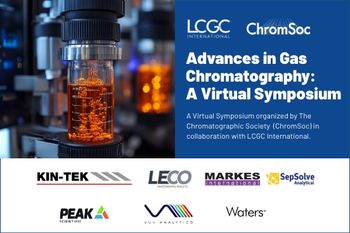
- The Application Notebook-07-01-2017
- Volume 30
- Issue 2
Determination of Sophisticated Honey Adulteration with LC–IRMS
Honey is a high-value commodity, whose quality is defined both by its botanical and geographical origin. This generates a strong consumer demand for certain, premium-priced products, which have become the target for adulterations. A useful tool to detect the addition of sugar to honey products is based on the well-documented difference in δ13C values between C3 (natural honey) and C4 (added sugar) plants. Coupling high performance liquid chromatography (HPLC) with isotope ratio mass spectrometry (LC–IRMS) has the unrivaled advantage of the simultaneous determination of δ13C values from glucose, fructose, di-, tri-, and oligo-saccharides, allowing the detection of more sophisticated honey adulteration with a simple user-friendly analytical system.
Marian de Reus, Filip Volders, Christian Schmidt, Lutz Lange, and Hans-Peter Sieper, Elementar Analysensysteme GmbH
Honey is a high-value commodity, whose quality is defined both by its botanical and geographical origin. This generates a strong consumer demand for certain, premium-priced products, which have become the target for adulterations. A useful tool to detect the addition of sugar to honey products is based on the well-documented difference in δ13C values between C3 (natural honey) and C4 (added sugar) plants. Coupling high performance liquid chromatography (HPLC) with isotope ratio mass spectrometry (LC–IRMS) has the unrivaled advantage of the simultaneous determination of δ13C values from glucose, fructose, di-, tri-, and oligo-saccharides, allowing the detection of more sophisticated honey adulteration with a simple user-friendly analytical system.
Instrumentation and Experimental Conditions
The system consists of an HPLC (Agilent 1260 Infinity system with 1290 column compartment), an LC–IRMS interface (Elementar iso CHROM LC cube), and an IRMS (Elementar isoprime precisION).
HPLC
Eluent: Water (LC–MS grade)
Column: 6.5 × 300 mm, 9-µm Dr. Maisch Repromer Ca
Column Temp.: 85 °C
Flow Rate: 0.27 mL/min or 0.60 mL/min
Injection Volume: 5 µL (conc.: 10 mg/mL)
LC-IRMS Interface
Combustion Temp.: 850 °C (at eluent flow rate of 0.27 mL/min)
1150 °C (at eluent flow rate of 0.60 mL/min)
Results
Unlike the existing LC–IRMS interface solution via chemical oxidation, the iso CHROM LC cube works with high-temperature combustion. Thanks to the low dispersion gas flow path, no significant peak tailing is observed that sacrifices chromatographic resolution. In addition, flow rates higher than 0.3 mL/min are now possible to reduce the run time and increase the number of samples per day.
In constant operation, more than 100 different honey samples were analyzed. A typical chromatogram is shown in Figure 1 for two different flow rates. Standards were measured between the honey samples to monitor the system performance. Overall 890 analyses were performed over a period of more than 3 weeks with just a few minor interventions, for example, change of chemical drying agent every 10 days or emptying the waste bottle every 5 days. The standard deviations over the whole period for the standards were as low as 0.07‰ for sucrose, 0.14‰ for glucose, and 0.13‰ for fructose.
Table 1 shows an excerpt of the results including adulterated honey samples. The standard deviation in all cases is excellent for glucose and fructose. For some samples, the disaccharides were also analyzed. A difference in the isotopic ratio between glucose and fructose of larger than 1‰ is evidence for adulteration (adulterated honey #1 in Table 1). A further sign of adulteration is if the isotopic ratio between glucose, fructose, di-, and trisaccharides differs by more than 2.1‰ (adulterated honey #2 in Table 1). The low difference between glucose and fructose for the German honey sample can be explained by the fact that it’s a non-commercial, single-source honey from a local beekeeper.
Conclusion
The LC–IRMS results using the iso CHROM LC cube LC–IRMS interface show outstanding performance and precision. The unrivaled robustness and the low intervention and maintenance intervals paired with the ability to significantly reduce the run time make it the perfect choice for any high-throughput laboratory that needs to detect sophisticated honey adulteration.
Elementar Analysensysteme GmbH
Elementar-Straße 1, D-63505 Langenselbold, Germany
Website:
Articles in this issue
over 8 years ago
The Rapid Determination of Mycotoxins by LC–MS/MSover 8 years ago
Direct Analysis of Amino Acids by HILIC–ESI-MSover 8 years ago
On-Line MALS-QELS (Quasi‑Elastic Light Scattering)over 8 years ago
Ensuring Protein Reagent Quality by SEC-MALSNewsletter
Join the global community of analytical scientists who trust LCGC for insights on the latest techniques, trends, and expert solutions in chromatography.





